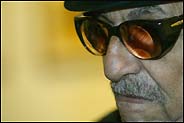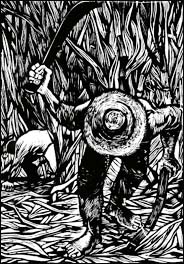|
 |
|
Esta página no está disponible en español. THE NEW YORK TIMES Painter Of The People: An Eye Trained on Puerto Rico's Traditions By MIREYA NAVARROMarch 26, 2003
PHOTO: Angel Franco/The New York Times Miguel Luciano first learned of Rafael Tufiño during one of Mr. Luciano's frequent visits to Puerto Rico as a child. Mr. Tufiño's posters were all over San Juan, in museums, on the walls of restaurants and in people's homes. Then, during one visit, they met in the typical way: Mr. Luciano ran into Mr. Tufiño, a gregarious master printmaker and painter, as he held court in a plaza in Old San Juan, where he lives and is a familiar figure along that colonial city's cobblestone streets. "Everybody's friends with Tufiño," said Mr. Luciano, now 30 and a painter himself in New York. "To know him is to love him." ---------- The work of Mr. Tufiño, 80, is the subject of a major retrospective — his first in the United States — at El Museo del Barrio in East Harlem that opened this month and runs through August. Although he is well known among art connoisseurs and has pieces in the permanent collections of many institutions, including the Library of Congress and the Metropolitan Museum of Art and the Museum of Modern Art in New York, Mr. Tufiño has not become as well known on the United States mainland as his art would warrant, officials at El Museo said. Known to many as the "Painter of the People," Mr. Tufiño depicts subjects from the everyday to the symbolic. In his paintings, drawings, graphics, posters and illustrations — 150 have been selected for El Museo's retrospective, spanning six decades — he has trained his eye on Puerto Rico's cultural heritage and traditions, particularly those of its African roots. To Puerto Ricans growing up and attending art schools away from the island, Mr. Tufiño has long been a touchstone. A Brooklyn native who has spent much of his life shuttling between the island and New York, Mr. Tufiño has inspired several generations of New York artists, trying to function as a bridge to people separated by distance but not culture. "That's been a dream as a Puerto Rican who was born here," Mr. Tufiño said in an interview in New York, where he has been visiting since November. "We're the same people." Artists like Mr. Luciano, who was born in Puerto Rico but grew up in the United States, say they were inspired by Mr. Tufiño's commitment to his culture and found an immediate connection to folkloric references that they never encountered in art history books in American schools. "Tufiño's work is Puerto Rico," Mr. Luciano said. "He has been so prolific that through his work you can follow the changing themes of our culture for more than half a century." Others, like the group of young painters who coalesced in the late 1960's in what became known as Taller Boricua, an art collective now at Lexington Avenue and 106th Street in East Harlem, said they found in Mr. Tufiño, a Taller co-founder and mentor, an answer to questions of identity. "We learned from Tufiño Puerto Rican aesthetics," said Marcos Dimas, the Taller's artistic director. "We looked at Tufiño's art as our root art and mixed it with our urban experience." Mr. Tufiño said nostalgia had been a driving force in his work. Born and reared near the Brooklyn Bridge as the only child of Puerto Rican parents — his father a merchant seaman, his mother a tobacco worker — he said he grew up hearing stories about Puerto Rico and fell in love with the island before setting foot on it. When he moved there at the age of 10 to live with a grandmother in a slum of San Juan, he said, he began drawing everything he saw. "To me it was like being Tom Sawyer," he said. "I was fascinated."
With the encouragement of a grade school teacher, he began reading art books and later learned painting and the trade of sign painting. In the 1940's, after serving in the Army, he went to Mexico for three years under the G.I. Bill for what turned out to be his only formal art schooling. Back in Puerto Rico Mr. Tufiño became part of the generation of artists of the 1950's, a critical period following the creation of the current commonwealth political status that gave the island a degree of autonomy. He was a pioneer in Puerto Rican graphic arts, and many of his prints document life in pre-industrial Puerto Rico. Some of his best-known pieces are posters and prints that were used in government-sponsored literacy and hygiene campaigns. (He was at one point director of the government's printmaking shop.) "He's an idealist," said Fatima Bercht, El Museo's chief curator. "His art is tied to the desire to improve the lives of people." But Mr. Tufiño was also drawn to the dance, music and popular customs of Puerto Rico, and to its women. The retrospective at El Museo, which was organized by the Museum of Art of Puerto Rico, includes many nudes, portraits and what is regarded as one of Mr. Tufiño's masterpieces, "Goyita," an oil painting of his mother, Gregoria Figueroa. While Mr. Tufiño has lived most of his life in Puerto Rico, New York always beckoned. He settled in East Harlem in the 1940's and ran a sign shop on East 116th Street for a year. He came back in the 1950's, once on a Guggenheim scholarship and on other occasions to tend to his ailing parents.
|

 ----------
----------
 ----------
----------